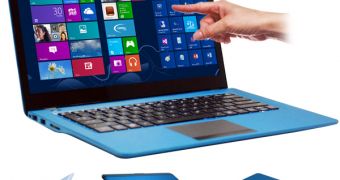The words “entry level” are used quite loosely these days, which is the only reason why the new laptop from Australian company Pioneer Computers is described as such, even though the price of $750 / 750 Euro isn't the best.
Then again, as far as ultrabooks go, there are very few who go below this mark, if any, and those that do sell for this much are very few indeed.
If nothing else, this will give Pioneer Computers a great advantage, especially since touch support wasn't neglected.
For comparison, Lenovo's ThinkPad Carbon X1 Touch has just appeared and costs twice as much as the Pioneer DreamBook T14.
Sadly, Pioneer had to sacrifice some features in order to strike such a bargain, to the point where the DreamBook T14 isn't at all what ultrabooks are cracked up to be.
The solid-state drive has to be of only 16 GB and there isn't any operating system installed.
Naturally, this hardware makes absolutely no sense, which is why buyers will have to pay extra if they really want this particular laptop.
A 64 GB SSD will demand $150 / 115-150 Euro, 128 GB will move things to $230 / 177-230 Euro, and Microsoft's Windows 8 operating system will add $102 of its own (79-102 Euro).
That takes the 14-inch laptop to $1,000 / 772-1,000 Euro, which definitely doesn't meet entry-level qualifications.
At least the screen has a touch panel. We suppose that it is possible to use cloud-based applications and somehow make do with just 16 GB on-board storage. It would give the words “entry level” a whole new meaning.
The rest of the specifications are decent enough at least: an Intel Core CPU is used (1.8 GHz Core i3, 1.7-2.6 GHz Core i5 or 1.9-3.0 GHz Core i7), along with 2-8 GB of RAM and the full set of connectivity and I/O: Gigabit Ethernet, USB 2.0 (two ports), USB 3.0 (one port), an HDMI output, a 1.3-megapixel camera, an SD card reader, Bluetooth and a 2.5-inch HDD.
The spec sheet doesn't make it clear, but if there is an HDD in there somewhere, maybe the 16 GB SSD is just a cache drive, although it does beg the question of why no OS is installed.

 14 DAY TRIAL //
14 DAY TRIAL //